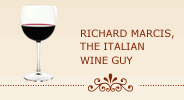Moscato d’Asti - Italy’s Fizzy and Fun Gift to the World
Moscato d’Asti (mos scah’ toh dah’ stee) is a lightly sweet and gently effervescent wine from the Piedmont region in northern Italy. While it is a festive and fun wine, it does have a sense of place and style that help explain why it ranks so high as one of Italy’s favorite wines.
Moscato d’Asti is related to - and often confused with - Asti Spumante (now called simply "Asti"). Both are DOCG wines made with the same grapes grown in the same general area. However, they are quite different. Moscato d’Asti is only lighly sparkling or frizzante as opposed to fully sparkling like Asti and also has more delicate flavors and lower alcohol than does Asti. Moscato d’Asti is a more elegant and rewarding choice than the typically bland and uber-sweet Asti and most knowledgeable wine drinkers will opt for Moscato d'Asti when given a choice between the two.
Moscato d’Asti is also extremely popular in the U.S. and elsewhere and exports of Moscato d’Asti to the U.S. have soared in recent years. Sales of Moscato d'Asti in the U.S. have increased sharply in recent years and reached 216 mllion bottles in 2016, Moscato sales have been particularly strong among the younger, twenty-something set, especially after several rap artists exuberantly endorsed Moscato a few years ago with hip-hop shout-outs.
The Moscato family includes a broad category of wines. The Moscato grape is one form of the ubiquitous Muscat grape that is grown all over the world. Since Moscato is the name of a grape variety, Moscato wines can be from anywhere in the world where Moscato is grown. Reflecting this geographic diversity, Moscato is found in a number of styles, from dry to over-the-top sweet and from still to fully-sparkling.
However, the focus here is on those Moscato wines known as Moscato d’Asti. Moscato d'Asti wines are made from a specific clone of the Moscato grape known as Moscato Bianco that is grown in designated areas around the town of Asti as well as in the nearby provinces of Alessandria and Cuneo in Italy’s Piedmont region. Moscato is the name of the grape and Asti is the town where it is produced. Moscato d’Asti means “Moscato of Asti” and is a trade and appellation-protected name.
Moscato d’Asti wines are lightly effervescent with a touch of sweetness, have lively acidity and delicate but complex aromas. While there are nuanced differences in styles of Moscato d’Asti among producers, in general they should have tropical fruit flavors with hints of orange and dried apricots on the finish.
While there are a lot of Moscato d’Asti wines to choose from, it is not as easy to make correctly as one might believe. Because of its delicacy and nuanced balance between sweetness and acidity, it requires know-how, experience and the proper technology to do it right.
Moscato d’Asti is made entirely from Moscato Bianco grapes grown on hillsides surrounding the town of Asti. After the grapes are hand-harvested in early September they are rushed to the winery where they are softly squeezed with manual presses. The resulting pulp and juice is then refrigerated in stainless steel tanks at low, near freezing temperatures in order to keep it from fermenting. This procedure helps insure the freshness and vitality of the wine.
After a period, the wine is then fermented in closed steel tanks that capture the carbon dioxide and store it in the form of bubbles. The fermentation is terminated when the alcohol content reaches its desired level of sweetness - usually around 5 percent - by chilling the fermenting wine until the yeasts stop working. Unlike fully-sparkling wines, the wine does not go through a second fermentation. The wine is kept fresh in the tank until it’s time for bottling. Then the wine is fined and filtered to take out any remaining yeast cells so fermentation won’t start later in the bottle and then is immediately bottled.
Because Moscato d’Asti wines do not go through a second fermentation they can be bottled at relatively lower pressure than other bubbly wines. Consequently, they are bottled with traditional cork stoppers in place of the wire-cage-over-cork-type stoppers found on Champagne and other sparkling wines. When a bottle of Moscato d’Asti is opened with a traditional corkscrew, there is, at most, a gentle “pop.”
Even though Moscato d’Asti has some residual sugar, it is such a sublime and delicate wine that there is no reason to keep it just for desserts. Moscato d'Asti's delicate fruit flavors, lively acidity and light profile mean that it can be served at a variety of occasions. It is very versatile and fits comfortably with a garden party, wedding party or a Sunday brunch as well as poolside on a summer day where the wine’s low alcohol (typically from 5 to 7 percent) means you won’t spend the rest of the afternoon in an alcoholic fog.
Moscato d’Asti has a natural affinity for a wide variety of foods. For example, Moscato pairs well with the following:
- A wide variety of appetizers, including paté and grilled salmon
- Fresh fruits and/or cold cuts - it is excellent with melon and prosciutto.
- Not-too-sweet desserts such as fresh fruit, fruit tarts, panettone, biscotti and sorbet. For a truly ambrosial treat, splash some Moscato over a bowl of fresh strawberries.
- Soft cheeses such as gorgonzola or mozzarella di bufala.
- Finally, Moscato is the ideal wine to serve at the end of an all-you-can-eat buffet (Thanksgiving and Christmas come to mind) where people are so stuffed they can barely make room for anything other than a glass of refreshing Moscato d’Asti.
Moscato d’Asti is a wine that should be drunk young, ideally no later than a few years after bottling. It is a wine meant for the table and not the cellar. Moscato d’Asti should be served slightly chilled.
In my opinion, it’s unusual to find a bad Moscato d’Asti DOCG wine. Moscato d’Asti is still produced by small, artisanal producers that care about the quality of their product. Of course, there are nuanced differences in style and some are better than others but you generally can’t go wrong with a DOCG Moscato d’Asti. That said, here is my list of 12 favorite Moscato d’Asti wines listed alphabetically by producer:
Cascina Fonda, “Bel Piano” Moscato d’Asti 2015 (about $19)
This wine is from the hills around the town of Mango, southwest of Asti. It has fragrant Moscato aromas with lively lemon and peach flavours . This would be my choice to accompany desserts such as fruit-based tarts, panettone or almond cakes.
Elio Perrone, “Sourgal” Moscato d’Asti 2016 (about $18)
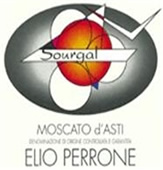 Sourgal (soor gahl) is golden in color and offers delightful aromas of dried fruit and spice. It is medium-bodied with good acidity that perfectl balances the intense tropical fruit flavors. The long and sweet finish is an added bonus. The perfect wine to serve with melons, strawberries and other fresh fruit.
Sourgal (soor gahl) is golden in color and offers delightful aromas of dried fruit and spice. It is medium-bodied with good acidity that perfectl balances the intense tropical fruit flavors. The long and sweet finish is an added bonus. The perfect wine to serve with melons, strawberries and other fresh fruit.
Ghione, “Piccole Gioie” Moscato d’Asti 2016 (about $15)
Piccole Gioie (“little joys”) is soft and sweet with lovely perfumed aromas of honey and peach blossoms. The creamy texture of this wine is balanced with a lively streak of acidity that makes it hard to resist.
Icardi,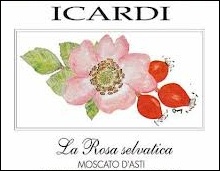 “La Rosa Selvatica” Moscato d’Asti 2015 (about $20)
“La Rosa Selvatica” Moscato d’Asti 2015 (about $20)
Straw yellow in color, this summer sipper sparkles with floral and white fruit aromas. It is sweet and delicate with peach, pear and melon flavors. It would go well with the vibrant flavors of various Pan-Asian dishes.
La Spinetta, “Bricco Quaglia” Moscato d’Asti 2016 (about $18)
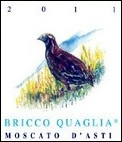 This vibrant sparkler has a gentle froth with exotic aromas of honey and jasmine and ginger notes on the finish. It has my vote as the perfect wine to serve at brunch or with lunches involving fresh fruit and assorted cheeses.
This vibrant sparkler has a gentle froth with exotic aromas of honey and jasmine and ginger notes on the finish. It has my vote as the perfect wine to serve at brunch or with lunches involving fresh fruit and assorted cheeses.
Lodali, Moscato d’Asti 2016 (about $13)
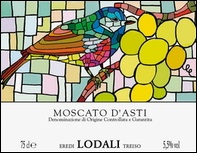 This is the least expensive wine on the list and is a real charmer. It has a light and sparkling quality that comes through in both its aromas and mouthfeel. The sweet fruit flavors are perfectly balanced with lively acidity.
This is the least expensive wine on the list and is a real charmer. It has a light and sparkling quality that comes through in both its aromas and mouthfeel. The sweet fruit flavors are perfectly balanced with lively acidity.
Marcarini, Moscato d’Asti 2015 (about $18)
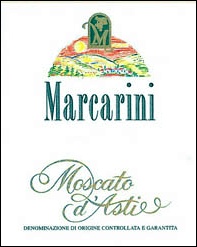 This Moscato is from one of the Piedmont’s leading producers of big, bold, high-profile reds. Fizzy, fruity and delicately sweet it is the perfect accompaniment to a wide range of pastries and not-too-sweet desserts.
This Moscato is from one of the Piedmont’s leading producers of big, bold, high-profile reds. Fizzy, fruity and delicately sweet it is the perfect accompaniment to a wide range of pastries and not-too-sweet desserts.
Massolini, 2010 Moscato d’Asti 2015 (about $20)
Light and delicate bubbles with a spritzy touch of lemon zest on the finish make this wine a perfect match with appetizers.
Michele Chiarlo, “Nivole” Moscato d’Asti 2016 (about $14 for a half bottle)
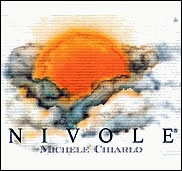 With its brightly-colored fetching label, light golden hue, engaging aromas and dense peach and nectarine flavors, the Nivole (which means “clouds” in the local Piemontese dialect) is an indulgent pleasure. It is ideally suited for any brunch involving fresh fruit tarts. For a more detailed review, see Nivole.
With its brightly-colored fetching label, light golden hue, engaging aromas and dense peach and nectarine flavors, the Nivole (which means “clouds” in the local Piemontese dialect) is an indulgent pleasure. It is ideally suited for any brunch involving fresh fruit tarts. For a more detailed review, see Nivole.
Saracco, Moscato d’Asti 2015 (about $14)
This wine is delicate, perfectly balanced and delicious. Even though it’s among the least expensive of the Moscato d’Asti wines on this list, Paolo Saracco’s version struts its stuff and shows how good a Moscato can be.
Seghesio, Moscato d’Asti 2010 (about $17)
Vibrant acidity perfectly balances the sweetness of this gentle wine. Loaded with honey and fresh fruit flavors with some citrus notes, this wine is the perfect accompaniment for light desserts involving fresh fruit or panettone or pignoli cookies.
Vietti, “Cascinetta” Moscato d’Asti 2015 (about $19)
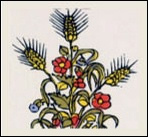 The Moscato grapes are hand-selected from 35 year-old vines on Vietti’s prime Castiglione Tinella vineyard just a few miles south of Asti. This sparkler is aromatic, pleasantly acidic and rich with fruit-driven flavors that make a perfect match for fruit-based desserts.
The Moscato grapes are hand-selected from 35 year-old vines on Vietti’s prime Castiglione Tinella vineyard just a few miles south of Asti. This sparkler is aromatic, pleasantly acidic and rich with fruit-driven flavors that make a perfect match for fruit-based desserts.
©Richard Marcis
Updated August 18, 2018
Return to italian wine reviews
Help keep this website ad-free and independent.
Consider making a contribution to support the work of WineWordsWisdom.com.

